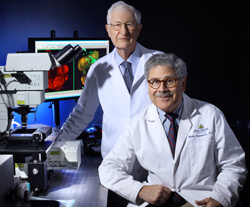

Hepatologist Esteban Mezey doesn’t fail to check the box 25-dihydroxyvitamin D3 for his patients’ blood studies. Those with alcoholic liver disease, chronic hepatitis or fatty liver are invariably deficient in the fat-soluble vitamin, especially when liver fibrosis is severe.
Recently, however, studies by Mezey, the basic scientist, give added motivation for checking vitamin D. He’s found a mechanism—how and where the active form of the vitamin damps an abnormally high output of type I collagen by hepatic cells. Type I collagen is essential in shifting a healthy liver to one occupied with scar-making fibrosis.
Fibrosis, of course, is part of healing, part of the body’s natural injury response. Its dark side comes, however, when chronic injury sends it into overdrive. Not a passive process as was once thought, fibrosis following chronic liver inflammation is a relentless cascade. It typically leads to cirrhosis, then end-stage liver disease or cancer. “The steps are all related,” says Mezey, “each increasing the risk of the next.”
In understanding the remodeling, Mezey has focused on the liver’s stellate cells—a key to the organ’s fine balance between collagen release and its breakdown. Normally, stellate cells hold that balance through quiet, molecular cross-talk with their surroundings. Prolonged injury, however, changes the conversation.
Preventing fibrosis is Mezey’s goal. And he’s turned to the fat-soluble vitamins.
“Hepatitis patients are really low in vitamins A, D and E,” he explains. It’s partly diet: The “fat solubles” are among vitamins that many cirrhosis patients fail to eat. Also, patients’ intestinal absorption of them is poor. But disease is also at work. Stellate cells normally store the fat solubles, Mezey says, unless they’re secreting collagen.
Might supplemental fat-soluble vitamins help? Mezey has shown that’s the case. Vitamin A clearly lowers collagen output in mouse models of fibrosis. So does vitamin E, especially in the company of selenium. Now this newest work with vitamin D shows that it, too, reins in collagen-secretion by stellate cells. The vitamin acts directly to inhibit stellate cells’ collagen genes, Mezey’s found.
He’s encouraged: “We’re hoping this form of vitamin D will prevent progression of fibrosis in patients at risk.” Larger patient studies to come will tell. For now, “the message is that we have to pay attention to these vitamins, especially D.”
Mezey’s work adds to the broadening perspective on fibrosis, says colleague Mark Donowitz, who heads a Johns Hopkins’ Conte center for digestive diseases’ basic and translational research. “It’s amazing,” he says. “We’d all studied inflammation and fibrosis in the esophagus, liver and intestine, thinking we were seeing specific diseases. Now we realize it’s the same process.”
To help get out that word, the researchers have organized a rare gathering of top national scientists on GI and liver fibrosis and its aftermath.
Learn more at the Conte symposium. See Mark Your Calendar for a list of upcoming symposiums.

